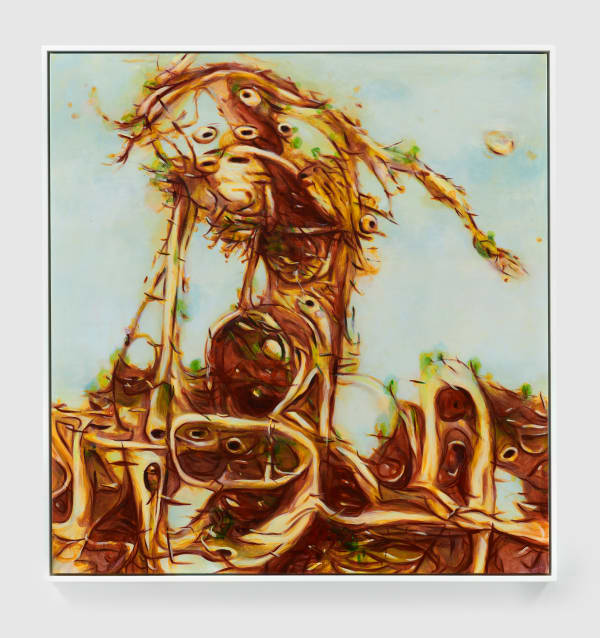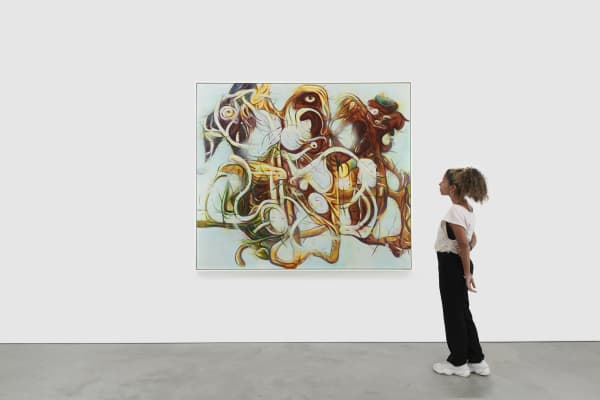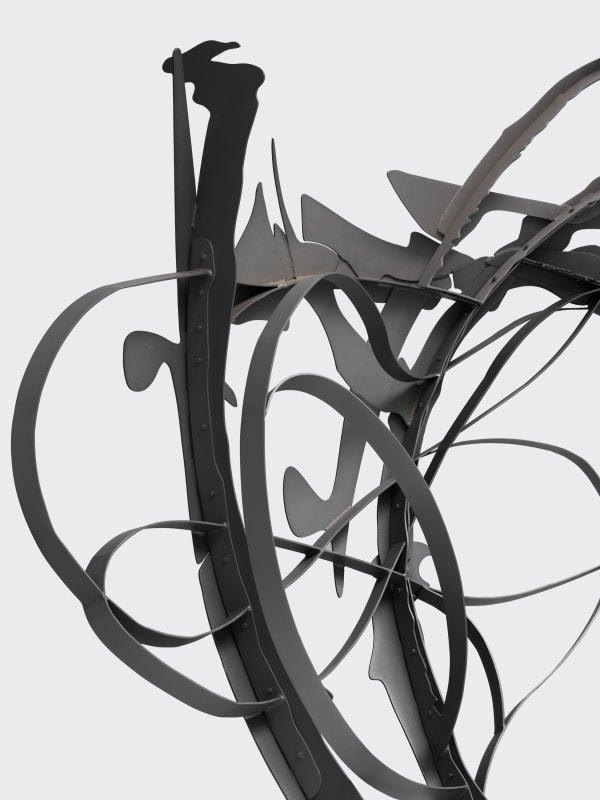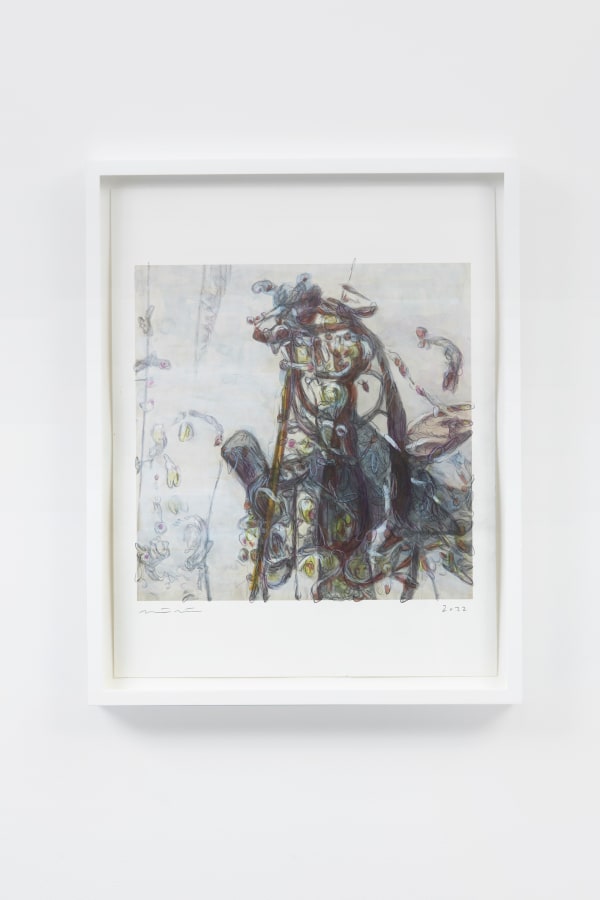-
-
A Garden in the Machine, Ritchie's first solo exhibition with James Cohan brings together a monumental sculpture with two new series of paintings and drawings, along with a related film. These works explore the ways in which Ritchie synthesizes systems; from the mathematical to the botanical to the poetic, to create a deeply personal language of expressive hybrid forms. The gesture becomes a means of teasing out the overlapping threads and knotty contradictions between seemingly disparate realms of understanding.
-
-
Ritchie’s new paintings depict looping vortexes of chimerical limbs and primeval roots, strange organic forms that seem to hover perpetually on the thresholds of cognition and formation.
-
In each work, he builds a richly evocative world that feels at once deeply familiar and eerily foreign. This push and pull between dissonance and harmony, between the beautiful and the grotesque, constitutes what he has referred to as the “plasmatic space of painting.”
-
-
These works are an outgrowth of Ritchie’s experimentation with a type of machine learning known as generative adversarial networks (GANs), which treat images as data from which to develop new imagery. For each of the series included in the exhibition, he trained the program using different databases of drawings, portraits, and landscapes drawn from the collection of the Metropolitan Museum of Art, medieval art, and his own works into a singular visual language. The GANs functions as an image generator from which he can intuitively build his own compositions.
-
For Ritchie, technology is most interesting in the ways it can provide a mirror of artistic thought. In the artist’s hands, the idea of artificial intelligence becomes highly subjective, allowing him to play with a personal art history.
-
-
The resulting paintings feel inhabited by the marks that make them, a summoning of ghostly forces through technological means–from the apocalyptic visions of Hieronymous Bosch and the spiritual abstractions of Georgiana Houghton to the idiosyncratic expressionism of James Ensor and Paul Nash, and the biomorphic figuration of Max Ernst and Arshile Gorky. Ritchie holds together the weight of histories embodied within the painted mark, while creating emancipatory and interpretative possibilities.
The New Yorker describes the outcome of the Matthew's investagative amalgamation of analog and digital as:
-
...primordial-soup abstractions, rendered in the artist’s hand on six-foot-wide surfaces, in a palette of ectoplasm and viscera, with grace notes of Eden...haunted by their human ancestors, from the anonymous sculptors who carved the Green Man on medieval churches to the German Surrealist Max Ernst, who shared Ritchie’s obsession with science. – Andrea Scott
-
-
Shadow Drawing, 2022, is an enveloping 10-foot high sculpture of laser-cut, powder-coated stainless steel that creates a landscape of line and shadow. Although the structure is fixed in solid steel, it appears on the precipice of change, hovering on the threshold of chaos and order. Its form was initially based on a mathematical model called a Henon attractor, which allows one to model chaotic orbits–in other words, to trace an almost untraceable line.
-
As a part of this work, which can be installed indoors or outdoors, the sculpture can be integrated with site-specific, native species planted within and around the sculpture. Ritchie’s intention is for the plantings to migrate and change naturally as they vie for resources, producing a “wild garden”, and ever-changing landscape of evolutionary competition at work.
-
-
I am interested in embodying evolution–art as an experimental garden for hybridity and the emergence of new forms.
– Matthew Ritchie
-
Caudex, 2022, a film by Ritchie, captures snapshots of the GANs as it runs through multiple serial progressions– what the artist terms “code walks”– in which new forms emerge and recede, guided by the artist’s hand and resembling a blooming garden of converging data. The film is accompanied by music written by Shara Nova, with lyrics by Ritchie, for Infinite Movement, their 2021 opera which casts the discriminator and the generator of the GANs as dueling characters.
-
MATTHEW RITCHIE
Caudex, 2022Looped digital animation with choral soundtrack by Shara Nova
10:54 duration
Edition of 3 plus 2 AP -
Ritchie’s work is marked by an enduring interest in multiple cultural traditions of imagery and storytelling. For the artist, everything is connected: the history of art, a creation myth or a gravitational theory are all attempts to speak to humanity’s place within and relationship to the universe.
-
-
The exhibition title, A Garden in the Machine, inverts the title of Leo Marx’s The Machine in the Garden, which described the arrival of the industrial age into the pastoral ideal. Ritchie finds both ghosts and gardens in the machine, connecting us to the artificial nature of today and the themes of complexity, climate change, and apocalypse that have long been a central focus of his work.
-
-
 MATTHEW RITCHIE, An Illustrated Lecture, 2022View more details
MATTHEW RITCHIE, An Illustrated Lecture, 2022View more details -
 MATTHEW RITCHIE, Gardener, 2022View more details
MATTHEW RITCHIE, Gardener, 2022View more details -
 MATTHEW RITCHIE, Composer, 2022View more details
MATTHEW RITCHIE, Composer, 2022View more details -
 MATTHEW RITCHIE, Harbinger, 2022View more details
MATTHEW RITCHIE, Harbinger, 2022View more details
-
 MATTHEW RITCHIE, Leaves, 2022View more details
MATTHEW RITCHIE, Leaves, 2022View more details -
 MATTHEW RITCHIE, Leaves, 2022View more details
MATTHEW RITCHIE, Leaves, 2022View more details -
 MATTHEW RITCHIE, Leaves, 2022View more details
MATTHEW RITCHIE, Leaves, 2022View more details -
 MATTHEW RITCHIE, Leaves, 2022View more details
MATTHEW RITCHIE, Leaves, 2022View more details
-
 MATTHEW RITCHIE, Leaves, 2022View more details
MATTHEW RITCHIE, Leaves, 2022View more details -
 MATTHEW RITCHIE, Leaves, 2022View more details
MATTHEW RITCHIE, Leaves, 2022View more details -
 MATTHEW RITCHIE, Leaves, 2022View more details
MATTHEW RITCHIE, Leaves, 2022View more details -
 MATTHEW RITCHIE, Leaves, 2022View more details
MATTHEW RITCHIE, Leaves, 2022View more details
-
-

Matthew Ritchie: A Garden in the Machine: Gallery Exhibition at 48 Walker Street
Past viewing_room


























